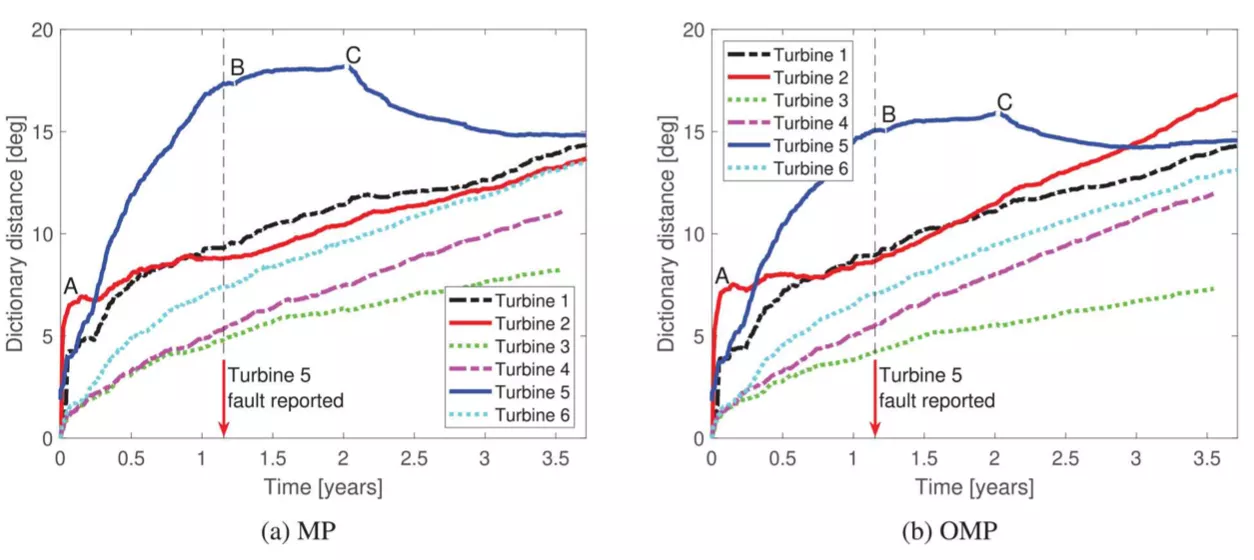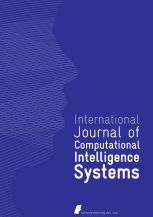博文
IJCIS | 字典学习有望使风力发电机组轴承监测更加智能
||
IJCIS | 字典学习有望使风力发电机组轴承监测更加智能
小编导读
风力发电是一种可再生能源,发展迅速,在欧盟提供了超过11%的电力。风电机组的使用寿命通常在20年,其状态监测和预测性维护是核心问题。齿轮箱是风力涡轮机的主要部件,支撑传动系统中旋转部件的滚动轴承对于可靠运行至关重要。鉴于风力涡轮机轴承故障占主导地位以及某些故障的复杂和微弱特征,监测这些轴承是一个重要且具有挑战性的问题。由于相邻的涡轮机面临相似的环境和操作条件,因此可以使用来自多台机器的数据对方法进行调整和验证。来自瑞典吕勒奥理工大学(Luleå University of Technology )的学者们在期刊 International Journal of Computional Intelligence Systems(IJCIS)上发表了题为“Dictionary Learning Approach to Monitoring of Wind Turbine Drivetrain Bearings” 的文章,研究了基于字典学习的风力发电机组轴承监测方法。
由于风力发电机组数量多、运行条件恶劣,风力发电机组的运行状况受到很大的挑战。特别是,预测性维修计划要求在很少误报的情况下及早发现故障。由于某些故障(尤其是涡轮传动系齿轮箱轴承上的故障)的复杂和微弱特征,实现这种类型的检测是一个具有挑战性的问题。以往使用字典学习解决状态监测任务的研究结果表明,无监督特征学习对于诊断和异常检测非常有用。然而,这些研究是基于在受控条件下运行的试验台的小组标记数据,这些数据集中在分类任务上,对定量方法比较有用,但对这些方法在实践中的有效性或现有状态监测系统如何使用知之甚少。
在本文中,我们研究了一种无监督字典学习方法,利用典型工业操作下46个月的振动数据进行状态监测。这种在线特征学习方法可以优化每台机器的监控特征集。特别是,我们使用字典学习来研究安装在瑞典北部风力发电厂2.5兆瓦涡轮机变速箱上的振动传感器记录的信号。学习的特征定义了一组过完备和移位不变的波形,用于确定相应振动信号的稀疏近似值。我们感兴趣的是从学习过程中获得的度量,这些度量可以用来跟踪这些波形随时间的变化,因此,它们可以作为检测异常变化的状态监测过程中的关键性能指标。我们也提供了公开的真实工业振动数据和新颖的测试结果。
在这项研究中,字典是从六个不同涡轮机的齿轮箱振动中学习出来的,当已知发生故障时,字典会在随后几年的监测数据中传播。我们使用了两种不同的稀疏编码算法进行实验,以研究所选算法是否会影响异常情况下的特征。我们提出了从字典学习过程中导出的字典距离度量作为一个条件指标,并发现异常字典适应的时间段从传动系轴承更换前6个月开始,到最终变速箱更换前一年开始。此外,我们还调查了在健康条件下,从地理位置相近的同类型涡轮机上学习到的词典之间的距离。我们发现学习到的特征是相似的,并且从一个涡轮机学习的字典可以用于监控类似的涡轮机。

图8 对于六台涡轮机,使用(a)匹配追踪(MP)和(b)或正交匹配追踪(OMP)算法,传播字典相对于基线字典的距离与时间的关系。标签A表示2号涡轮机数据采集系统中可能存在电气故障的时间段结束。此外,标签B表示涡轮5中输出轴轴承更换的时间段,标签C表示后续齿轮箱更换。
结论:这项工作的重点是使用无监督字典学习方法和已公开的真实风力涡轮机振动数据来监测风力涡轮机中的滚动轴承。上述结果表明,基于字典距离度量的状态指示器可用于风力涡轮机传动系齿轮箱轴承的监测,并可作为现有方法的补充。图8所示的结果表明,5号涡轮机的异常行为可以在几个月前使用字典学习进行检测。早期检测到涡轮机中的故障意味着在维护计划和降低昂贵故障风险方面的改进。然而,还需要进一步的测试来理解词典学习方法在实际的大规模监控环境中的优势和劣势。例如,我们不知道图8中观察到的长期偏离基线字典的现象是与涡轮机的机械磨损有关,还是与NP-hard字典学习问题的贪婪近似有关。进一步的测试需要从大量涡轮机中获取和处理状态监测数据,包括记录的故障和维护活动。
参考文献
[1] Global Wind Energy Council, Global wind Report-Annual Market Update 2017, Global Wind Energy Council, Brussels, Belgium, 2018.
[2] A. Crowther, V. Ramakrishnan, N.A. Zaidi, C. Halse, Sources of time-varying contact stress and misalignments in wind turbine planetary sets, Wind Energy. 14 (2011), 637–651.
[3] W. Liu, A review on wind turbine noise mechanism and denoising techniques, Renew. Energy. 108 (2017), 311–320.
[4] M.L.Hossain, A.Abu-Siada, S.M.Muyeen, Methods for advanced wind turbine condition monitoring and early diagnosis: aliterature review, Energies. 11 (2018), 1–14.
[5] F.P. Garcia-Marquez, A.M. Tobias, J.M.P. Perez, M. Papaelias, Condition monitoring of wind turbines: techniques and methods, Renew. Energy. 46 (2012), 169–178.
[6] S. Lacey, An overview of bearing vibration analysis, Maintenance Asset Manag. 23 (2008), 32–42.
[7] A.K.Jardine, D.Lin, D.Banjevic, A review on machinery diagnostics and prognostics implementing condition-based maintenance, Mech. Syst. Signal Process. 20 (2006), 1483–1510.
[8] W.P.Tse, T.J.Leung, Advanced system for automatically detecting faults occurring in bearings, in: L.M. Simon (Ed.), Fault Detection: Theory, Methods and Systems, Nova Science Publishers, New York, NY, USA, 2011, pp. 1–67.
[9] H. Dias Machado de Azevedo, A.M. Araujo, N. Bouchonneau, A review of wind turbine bearing condition monitoring: state of the art and challenges, Renew. Sustain. Energy Rev. 56 (2016), 368–379.
[10] A.Rai, S.Upadhyay, A review on signal processing techniques utilized in the fault diagnosis of rolling element bearings, Tribol. Int. 96 (2016), 289–306.
[11] R.B. Randall, J. Antoni, Rolling element bearing diagnostics– a tutorial, Mech. Syst. Signal Process. 25 (2011), 485–520.
[12] S. Mallat, A Wavelet Tour of Signal Processing: The Sparse Way, third ed., Academic Press, Burlington, MA, USA, 2009.
[13] V.Papyan, Y.Romano, J.Sulam, M.Elad, Theoretical foundations of deep learning via sparse representations: amultilayer sparse model and its connection to convolutional neural networks, IEEE Signal Process. Mag. 35 (2018), 72–89.
[14] M.Elad, Sparse and Redundant Representations: From Theory to Applications in Signal and Image Processing, Springer, New York, NY, USA, 2010.
[15] A.Bruckstein, D.Donoho, M.Elad, From sparse solutions of systems of equations to sparse modeling of signals and images, SIAM Rev. 51 (2009), 34–81.
[16] J.-L. Starck, F. Murtagh, J. Fadili, Sparse Image and Signal Processing: Wavelets, Curvelets, Morphological Diversity, Cambridge University Press, New York, NY, USA, 2010.
[17] E. Smith, M.S. Lewicki, Efficient coding of time-relative structure using spikes, Neural Comput. 17 (2005), 19–45.
[18] E. Smith, M.S. Lewicki, Efficient auditory coding, Nature. 439 (2006), 978–982.
[19] B. Olshausen, D. Field, Emergence of simple-cell receptive field properties by learning a sparse code for natural images, Nature. 381 (1996), 607–609.
[20] B.A. Olshausen, D.J. Field, Sparse coding with an overcomplete basis set: astrategy employed by V1?, Vision Res. 37 (1997), 3311–3325.
[21] S. Martin-del-Campo, F. Sandin, Towards zero-configuration condition monitoring based on dictionary learning, in 23rd European Signal Processing Conference (EUSIPCO), Nice, France, 2015, pp. 1306–1310.
[22] H. Liu, C. Liu, Y. Huang, Adaptive feature extraction using sparse coding for machinery fault diagnosis, Mech. Syst. Signal Process. 25 (2011), 558–574.
[23] S. Martin-del-Campo, K. Albertsson, J. Nilsson, J. Eliasson, F. Sandin, FPGA prototype of machine learning analog-to-feature converter for event-based succinct representation of signals, in Machine Learning for Signal Processing, IEEE International Workshop, Southampton, UK, 2013.
[24] X. Chen, Z. Du, J. Li, X. Li, H. Zhang, Compressed sensing based on dictionary learning for extracting impulse components, Signal Process. 96 (2014), 94–109.
[25] H. Tang, J. Chen, G. Dong, Sparse representation based latent components analysis for machinery weak fault detection, Mech. Syst. Signal Process. 46 (2014), 373–388.
[26] H. Ahmed, M. Wong, A. Nandi, Intelligent condition monitoring method for bearing faults from highly compressed measurements using sparse over-complete features, Mech. Syst. Signal Proces. 99 (2018), 459–477.
[27] M. He, D. He, J. Yoon, T.J. Nostrand, J. Zhu, E. Bechhoefer, Wind turbine planetary gearbox feature extraction and fault diagnosis using a deep-learning-based approach, Proc. Inst. Mech. Eng. Part O J. Risk Reliab. 233 (2019), 303–316.
[28] X. Wang, H.Z. Zhu, T. Rui, Y. Li, T. Liu, M. Liu, Shift invariant sparse coding ensemble and its application in rolling bear- ing fault diagnosis, J. Vibroeng. 17 (2015), 1837–1848. https:// www.jvejournals.com/article/15739
[29] H. Zhou, J. Chen, G. Dong, R. Wang, Detection and diagnosis of bearing faults using shift-invariant dictionary learning and hid- den markov model, Mech. Syst. Signal Process. 72–73 (2016), 65–79.
[30] S. Mallat, Z. Zhang, Matching pursuits with time-frequency dic- tionaries, IEEE Trans. Signal Process. 41 (1993), 3397–3415.
[31] Y.C. Pati, R. Rezahfar, P.S. Krishnaprasad, Orthogonal matching pursuit: Recursive function approximation with applications to wavelet decomposition, in The Twenty-Seventh Asilomar Conference on Signals, Systems and Computers, Pacific Grove, CA, USA, 1993, pp. 40–44.
[32] A. Szlam, K. Kavukcuoglu, Y. LeCun, Convolutional matching pursuit and dictionary training, ArXiv e-prints, 2010.
[33] Ethos-N Processor Series: Ethos-N57, Arm, 2020. https://armkeil.blob.core.windows.net/developer/Files/pdf/ethos/arm-ethos-n57-product-brief.pdf
[34] B. Mailhe, R. Gribonval, F. Bimbot, P. Vandergheynst, A low complexity orthogonal matching pursuit for sparse signal approxi- mation with shift-invariant dictionaries, in IEEE International Conference on Acoustics, Speech and Signal Processing (ICASSP 2009), Taipei, Taiwan, 2009, pp. 3445–3448.
[35] T. Blumensath, M. Davies, Gradient pursuits, IEEE Trans. Signal Process. 56 (2008), 2370–2382.
[36] F. Sandin, S. Martin-del-Campo, Dictionary Learning with Equiprobable Matching Pursuit, in International Joint Conference on Neural Networks (IJCNN), Anchorage, Alaska, 2017.
[37] S. Martin-del-Campo, F. Sandin, S. Schnabel, P. Marklund, J. Delsing, Exploratory analysis of acoustic emissions in steel using dictionary learning, in 2016 IEEE International Ultrasonics Sym- posium (IUS), Tours, France, 2016, pp. 1–4.
[38] K. Skretting, K. Engan, Learned dictionaries for sparse image representation: properties and results, in SPIE Proceedings, San Diego, CA, USA, 2011, vol. 8138.
[39] S. Martin-del-Campo, F. Sandin, Online feature learning for condition monitoring of rotating machinery, Eng. Appl. Artif. Intell. 64 (2017), 187–196.
[40] K. Loparo, Bearing Vibration Data Set, Case Western Reserve University, 2003. http://csegroups.case.edu/bearingdatacenter/
[41] T. Fawcett, An introduction to ROC analysis, Pattern Recognit. Lett. 27 (2006), 861–874.
[42] M. Seibert, J. Wörmann, R. Gribonval, M. Kleinsteuber, Learning co-sparse analysis operators with separable structures, IEEE Trans. Signal Process. 64 (2016), 120–130.
原文信息
S. Martin-del-Campo, F. Sandin, D. Strömbergsson, "Dictionary Learning Approach to Monitoring of Wind Turbine Drivetrain Bearings", International Journal of Computational Intelligence systems, 2020, DOI: 10.2991/ijcis.d.201105.001.

扫描二维码,获取英文原文
https://www.atlantis-press.com/journals/ijcis/125946150
关于期刊

Impact Factor: 1.838, CiteScore: 3.59
International Journal of Computational Intelligence Systems(IJCIS)是欧洲模糊逻辑和技术学(EUSFLAT)会刊,主要刊载有关应用计算智能各个方面的原创性研究,尤其是针对证明使用了计算智能理论的技术和方法的研究型论文及综述等,由西班牙哈恩大学Luis Martínez Lopez教授和澳大利亚悉尼科技大学路节教授担任共同主编。本刊目前已被DOAJ, Science Citation Index Expanded (SCIE), Ei Compendex and Scopus等数据库收录。
版权声明:
*本文内容由Atlantis Press中国办公室编辑。欢迎转发。如需转载,请在留言区留言,或联系xin.guo@atlantis-press.com。

https://wap.sciencenet.cn/blog-3453320-1270351.html
上一篇:合集荐读 | Journal of Robotics, Networking and Artificial Life
下一篇:Atlantis Press正式并入Springer Nature